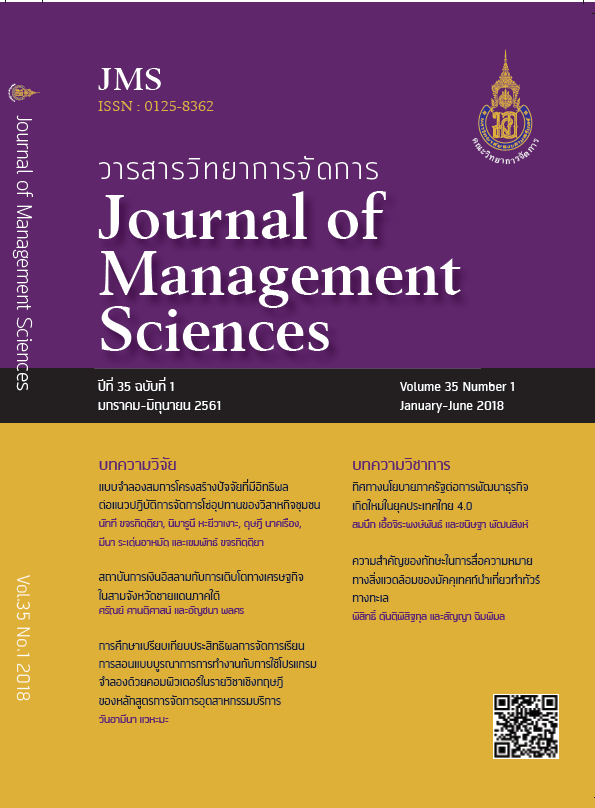ทิศทางนโยบายภาครัฐต่อการพัฒนาธุรกิจเกิดใหม่ในยุคประเทศไทย 4.0
Main Article Content
บทคัดย่อ
บทความนี้มีวัตถุประสงค์เพื่อศึกษาขั้นตอนการพัฒนาธุรกิจของธุรกิจเกิดใหม่ (Startup) และศึกษามาตรการส่งเสริมของหน่วยงานภาครัฐในการพัฒนาธุรกิจ Startup ตามนโยบายประเทศไทย 4.0 โดยใช้วิธีเก็บรวบรวมข้อมูลจากเอกสารงานวิจัยและเอกสารของหน่วยงานภาครัฐที่เกี่ยวข้อง จากการวิเคราะห์ข้อมูล พบว่า ขั้นตอนการพัฒนาธุรกิจ Startup ประกอบด้วย 4 ขั้นตอน ได้แก่ (1) ขั้นพัฒนาแนวคิด (Idea Stage) เป็นช่วงของการพัฒนาแนวคิดและเปลี่ยนแนวคิดให้เป็นผลิตภัณฑ์หรือบริการ (2) ขั้นทดสอบตลาด (Market Testing Stage) เป็นช่วงนำผลิตภัณฑ์ไปทดลองกับตลาดและนำข้อมูลสะท้อนกลับมาพัฒนาปรับปรุงผลิตภัณฑ์ให้ตรงกับความต้องการของตลาด (3) ขั้นเติบโต (Growth Stage) เป็นช่วงที่ต้องขยายธุรกิจ ขยายตลาด ดึงดูดนักลงทุนและทีมงานให้เข้ามาช่วยเร่งการเติบโตของธุรกิจ และ (4) ขั้นเก็บเกี่ยว (Harvest Stage) เป็นช่วงที่เปลี่ยนจากธุรกิจ Startup เป็นองค์กรธุรกิจเต็มรูปแบบ เข้าสู่ช่วงมั่นคงและพร้อมที่จะออกจากธุรกิจ (Exit) ปัจจุบันหน่วยงานภาครัฐมีมาตรการส่งเสริมการพัฒนาศักยภาพของธุรกิจ Startup ในแต่ละขั้นตอน คือ ขั้นที่ 1 และ ขั้นที่ 2 ภาครัฐมีมาตรการสร้างภาวะความเป็นผู้ประกอบการและพัฒนากำลังคนด้านดิจิทัล มาตรการส่งเสริมด้านการวิจัยและพัฒนา มาตรการพัฒนาเขตนวัตกรรม มาตรการจัดตั้งกองทุนร่วมลงทุน และมาตรการจดสิทธิบัตรทรัพย์สินทางปัญญา อบรมให้ความรู้เกี่ยวกับกฎหมายทรัพย์สินทางปัญญาและการแปลงทรัพย์สินทางปัญญาให้เป็นทุน ขั้นที่ 3 ภาครัฐมีมาตรการส่งเสริมการขยายตัวทางด้านการตลาด มาตรการส่งเสริมการเข้าถึงแหล่งทุนดอกเบี้ยต่ำ มาตรการสิทธิประโยชน์ทางภาษี และมาตรการสร้างฐานข้อมูลของธุรกิจ Startup และขั้นที่ 4 ภาครัฐมีมาตรการส่งเสริมตรายี่ห้อสินค้าและบริการไทยสู่ตลาดโลก และมาตรการพัฒนาตลาดทุน โดยมาตรการสนับสนุนดังกล่าวมีความสอดคล้องกับยุทธศาสตร์ชาติ 20 ปี (พ.ศ. 2560 - 2579) ซึ่งเป็นแผนพัฒนาประเทศเพื่อให้บรรลุวิสัยทัศน์ “ประเทศไทยมีความมั่นคง มั่งคั่ง และยั่งยืน”
Article Details

This work is licensed under a Creative Commons Attribution-NonCommercial-NoDerivatives 4.0 International License.
บทความที่ตีพิมพ์ถือเป็นลิขสิทธิ์ของวารสารวิทยาการจัดการ มหาวิทยาลัยสงขลานครินทร์ อย่างไรก็ตาม กองบรรณาธิการไม่สงวนลิขสิทธิ์ในการทำซ้ำ คัดลอก หรือเผยแพร่ แต่จะต้องอ้างอิงให้ถูกต้องตามหลักวิชาการ
References
Aujirapongpan, S., Vadhanasindhu, P., Chandrachai, A., & Cooparat, P. (2010). Innovation: Terms and classifications on Innovation which play vital role in the Innovation Capability of the entrepreneurs. Journal of Business Administration, 33(128), 49-65.
Blank, S. (2013). The Four Steps to Epiphany: Successful Strategies for products that win. Menlo Park: K&S Ranch.
Blank, S. (2013). Why the lean Start-up Change Everything. Harvard Business Review, 91, 63-72.
Bureau of Cooperation and Promotion. (2012). New Business Fund. Retrieved August 19, 2017, from https://www.mua.go.th/ users/bphe/ bs/money.html
Deelers, S., Tantasanawong, P., & Aujirapongpan, S. (2016). Creative Thinking of Undergraduates in the Higher Education Institute with Creative Identity. WMS Journal of Management. 6(1), 16-25.
Digital Economy Promotion Agency. (2017). DEPA unveils four measures to promote digital startup. Retrieved August 9, 2017, from https://www.depa.or.th
Global Entrepreneurship Development Institute. (2017). Global Entrepreneurship Index. Retrieved July 14, 2017, from https://thegedi.org
Government Spokesman Bureau, The Secretariat of the Prime Minister. (2016). Startup Thailand 4.0. Thai Khu Fah Journal, (31), 16-22.
Graham, P. (2012). Startup = Growth. Retrieved June 26, 2017, from https://www.paulgraham.com/growth.html
Jiraphanumes, K., Aujirapongpan, S., & Chamchang, P. (2011). The Effect of Entrepreneurial and Strategic Orientation on Innovativeness and Performance: The Empirical Study of the Listed Companies in the Market for Alternative Investment (MAI). Journal of Management Sciences, 28(1), 1-15.
Johnson, D. (2001). What is Innovation and Entrepreneurship? Lesson for Large Organizations. Industrial and Commercial Training, 33(4), 135-140.
Jongyusuk, A. (2016). Tax measures to promote new entrepreneurs (New Start-up). The Revenue Department Magazine, (March, 2016), 16-19.
Kollmann, T. (2006). What is e-entrepreneurship?-fundamentals of company founding in the net economy. Int. J. Technology Management, 33(4), 322-340.
Llorach, C., & Ottosson, E. (2016).The Balanced Scorecard during the early stages of a tech firm - A multiple case study regarding performance management in Swedish tech startups. Uppsala University. Sweden.
Love, H. (2016). The Start-Up J Curve: the Six Steps to Entrepreneurial Success. Texas: Greenleaf Book Group Press.
Mann, C. L. & Sanyal, P. (2010). The Financial Structure of Startup Firms: The Role of Assets, Information, and Entrepreneur Characteristics. FRB of Boston Working Papers, (10-17), 1-29.
Maurya, A. (2012). Running Lean: Iterate from Plan A to a Plan That Works (2nd Ed.). California: O’Reilly Media.
McClure, D. (2013). What is the proper definition of a startup. Retrieved June 26, 2017, from https://www.quora.com
Measincee, S. (2016). Thailand 4.0. Retrieved August 9, 2017, from https://planning2.mju.ac.th/goverment/20111119104835_planning/ Doc_25590823143652_358135.pdf
Ministry of Commerce News. (2016). The Ministry of Commerce is going to develop and promote Thai SMEs/Startup to the global market. Retrieved August 14, 2017, from https://moc.go.th
Moore, B. (1994). Finance constraints to the growth and development of a small high technology firms. In Huges, A. and Storey, D. J. (eds.). Finance and the small firm. London, Routledge, 112-114.
Mueller, S., Volery, T. & Von Siemens, B. (2012). What Do Entrepreneurs Actually Do? An Observational Study of Entrepreneurs' Everyday Behavior in the Start-Up and Growth Stages. Entrepreneurship Theory and Practice, 36(5), 995-1017.
NAVA. (2015). National Venture Capital Association Yearbook 2015. Retrieved July 23, 2017, from https://mthightech.org/wp-content/uploads/2015/11/NVCA-Yearbook-2015.pdf
Office of Small and Medium Enterprises Promotion. (2017). Startup development program. Retrieved August 9, 2017, from https://www.startuptracking.com
Office of the National Economic and Social Development Board. (2016). The 12th National Economic and Social Development Plan
(2017-2021). Retrieved December 20, 2017, from https://www.nesdb.go.th/ewt_dl_link.php?nid=6422
Office of the National Economic and Social Development Board. (2016). 20-Year National Strategy (2017 - 2036). Retrieved December 20, 2017, from https://www.nesdb.go.th
Paschen, J. (2017). Choose wisely: Crowdfunding through the stages of the startup life cycle. Business Horizons, 60(2), 179-188
Phokachai, T., & Warapongdee, N. (2016). 9 Startups: Revolutionary concept of startup business. Bangkok: Amarin Printing and Publishing.
Ries, E. (2011). The Lean Startup: How today’s entrepreneurs use continuous innovation to create radically successful businesses. New York: Crow Business.
Royal Thai Government. (2017). Government House News: Minister of Science and Technology Interview with MICESpotlight by NCC on the Development and Promotion of Startup Thailand and Startup Thailand 2017. Retrieved August 19, 2017, from https://www.thaigov.go.th/news/contents/details/2902
SME Development Bank. (2017). SME Development Bank joins Money Expo 2017 in Bangkok, low interest loans, special promotion, launch into Digital 4.0 with its innovative electronic finance loan service. Retrieved June 26, 2017, from https://www.smebank.co.th
STEM Education Thailand. (2014). What is STEM Education?. Retrieved August 19, 2017, from https://www.stemedthailand.org
Thailand Tech Startup Association. (2016). The Whitepaper for Startup Thailand 2016. Retrieved June 26, 2017, from https://www.thailandstartup.org/whitepaper.pdf
The Government Public Relations Department. (2016). Startup Thailand 2016. Government Newsletters for the People. 2(27), 1-12.
The Government Public Relations Department. (2016). Thailand 4.0. Government Newsletters for the People. 2(26), 1-12.
Thesarin, B. (2016). Thailand 4.0 New Economy Model. Retrieved June 21, 2017, from https://www.drborworn.com
The Secretariat of the Cabinet. (2014). SMEs Private Equity trust fund. Retrieved August 14, 2017, from https://www.cabinet.soc.go.th
The Stock Exchange of Thailand. (2017). SET News: SET launched the "LIVE" platform at Startup Thailand, launching a platform to increase liquidity. Available Q3 this year. Retrieved August 19, 2017, from https://www.set.or.th/set/newsdetails.do?newsId=14992117712031
The World Bank. (2017). World Bank Country and Lending Groups. Retrieved July 14, 2017, from https://datahelpdesk.worldbank.org
Van Praag, C.M. & Versloot, P.H. (2007). What is the value of entrepreneurship? A review of recent research. Small Bus Econ, 29(4), 351-382.
Warapongdee, N. (2017). SET Your Startup Business Guide. Bangkok: The Stock Exchange of Thailand.
Xiao, L. (2011). Financing high-tech SMEs in China: A three-stage model of business development. Entrepreneurship & Regional Development, 23(3–4), 217–234.
